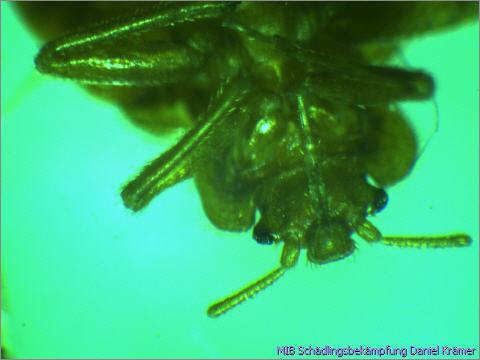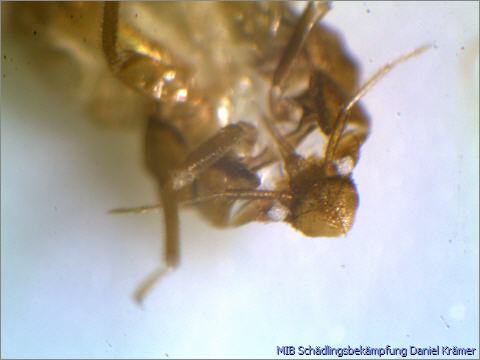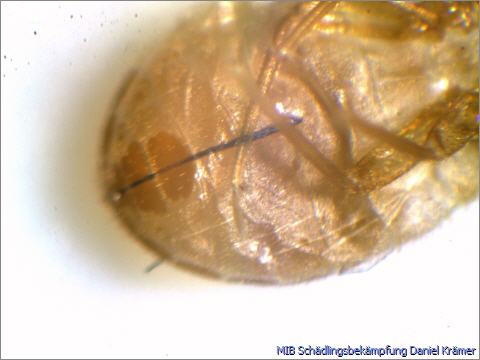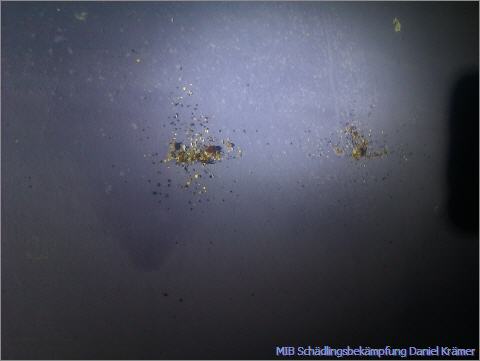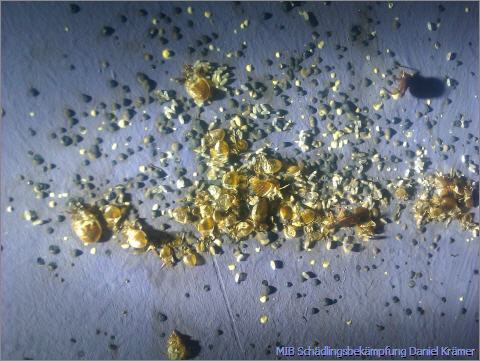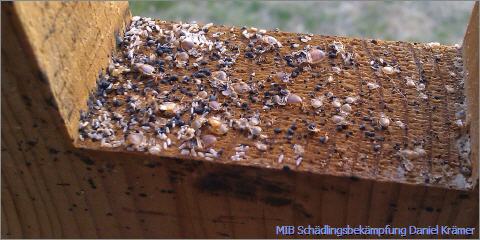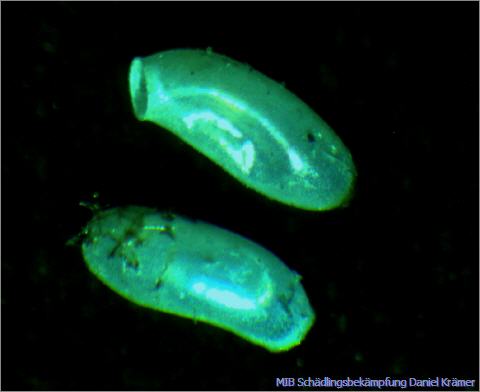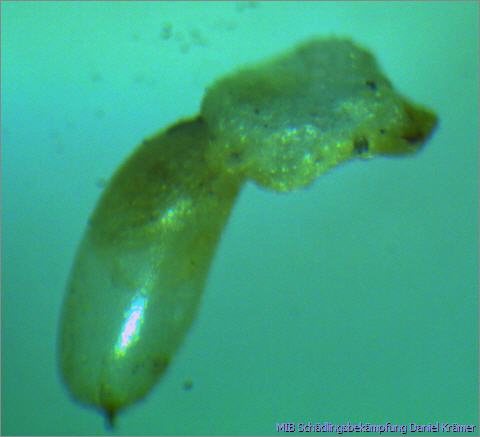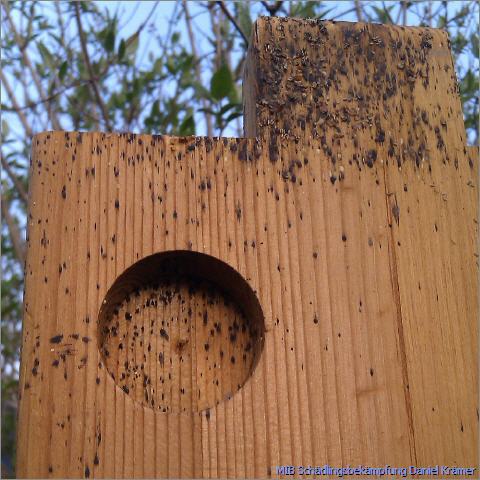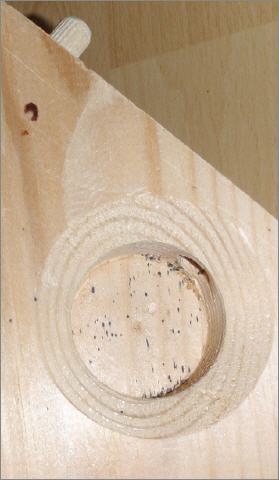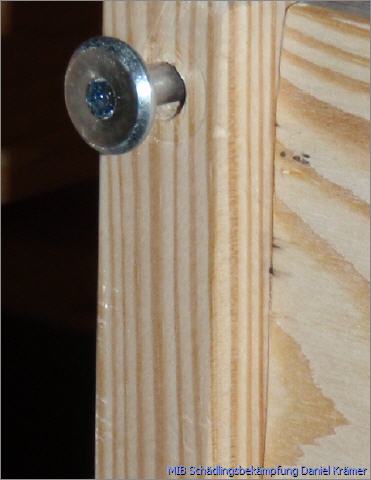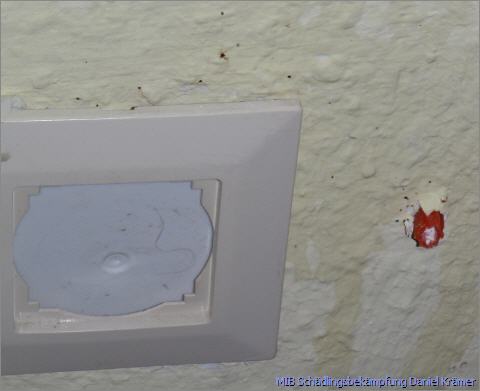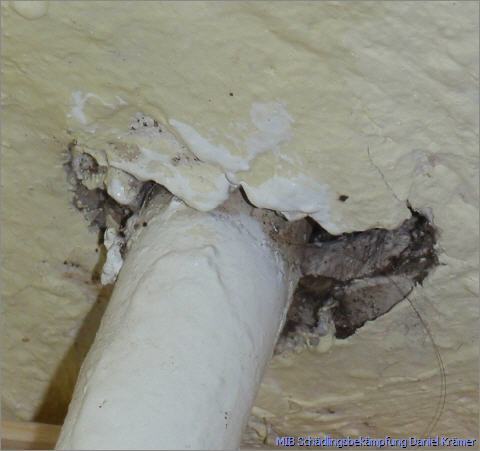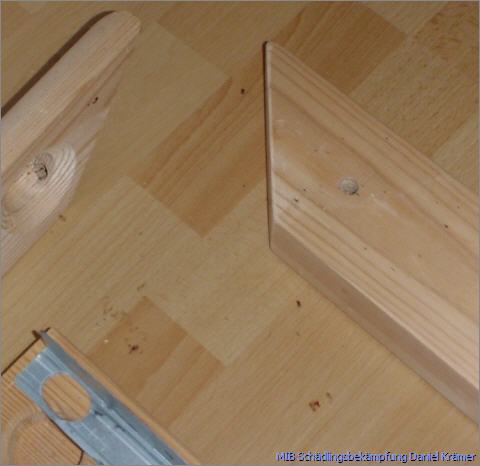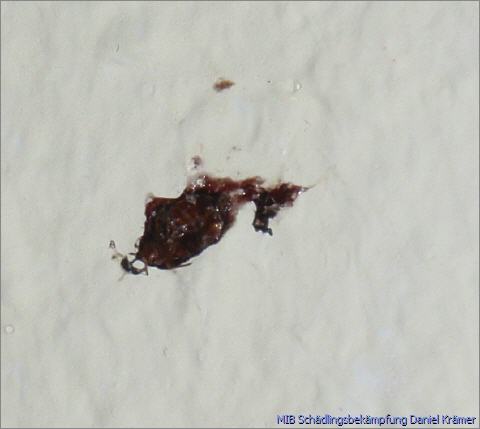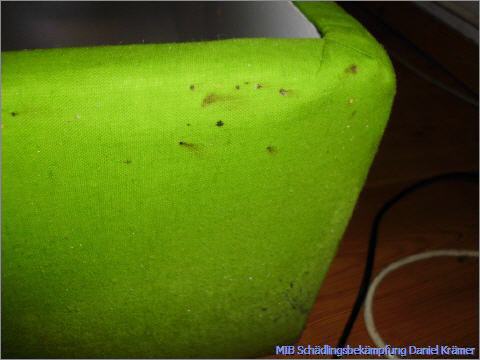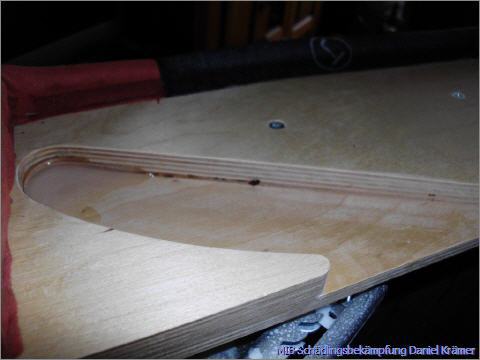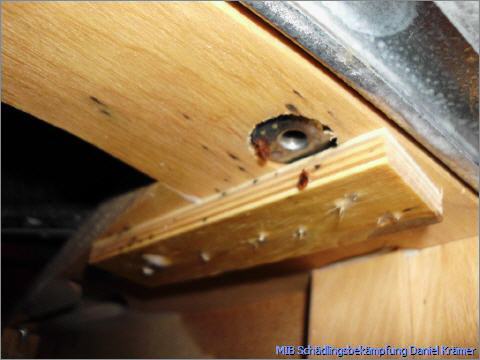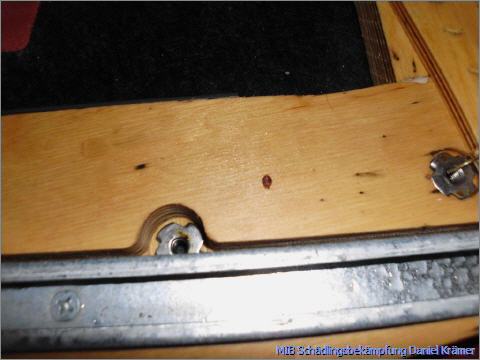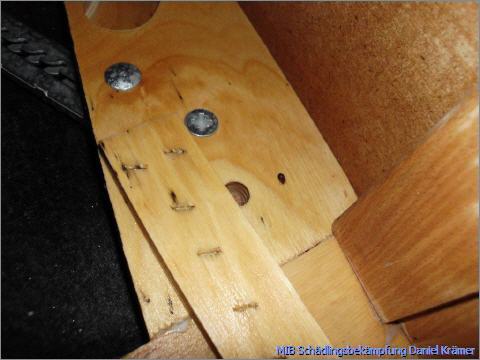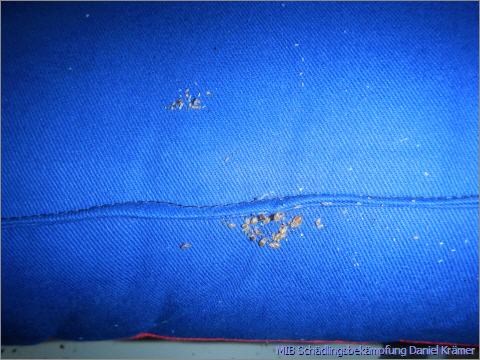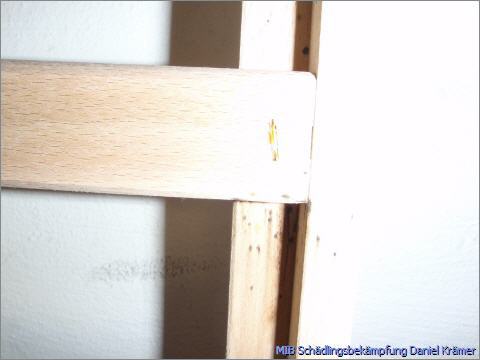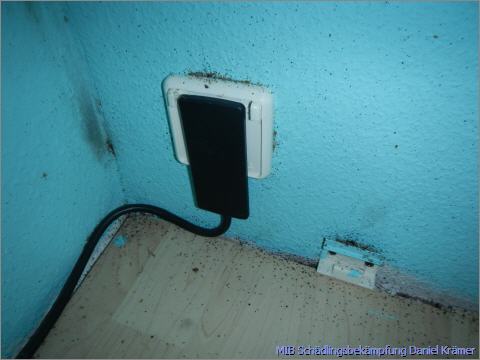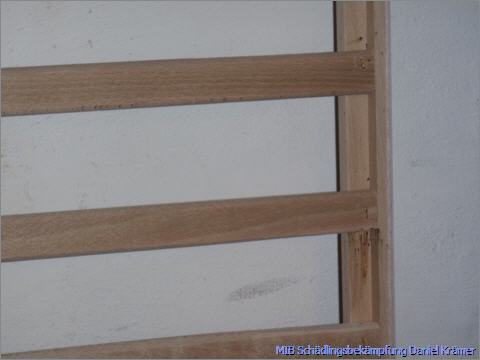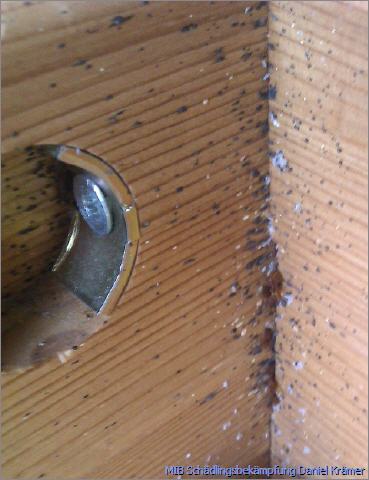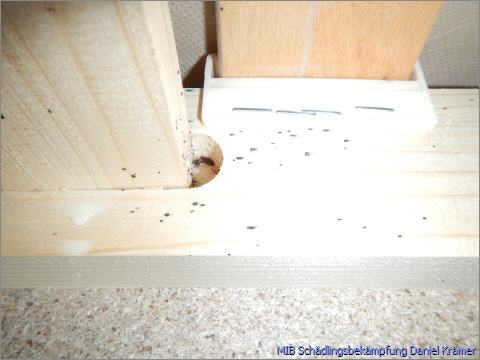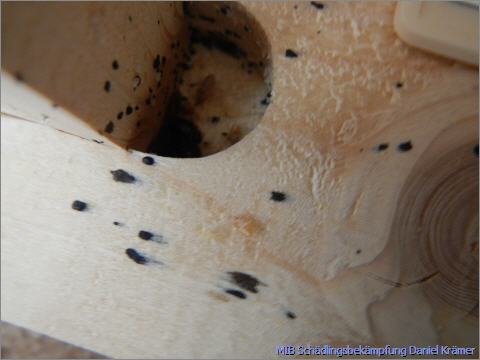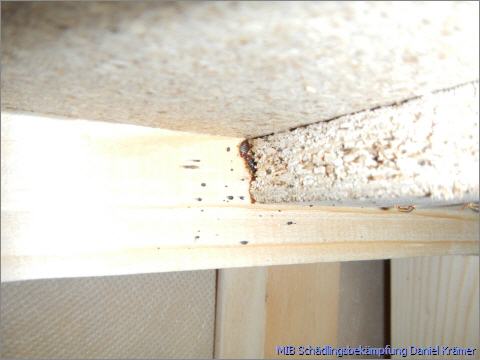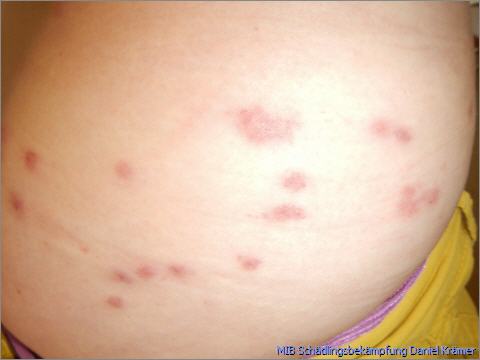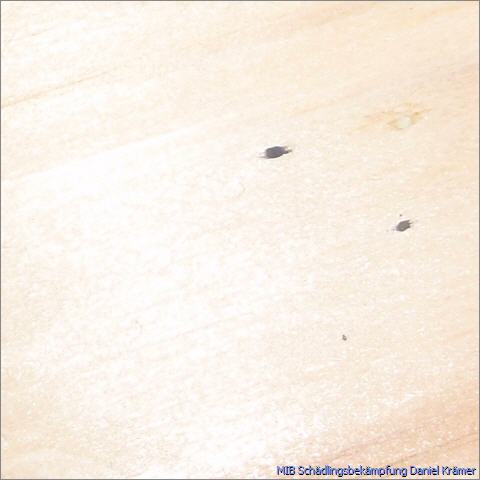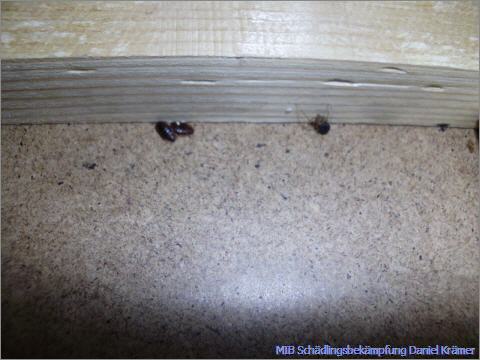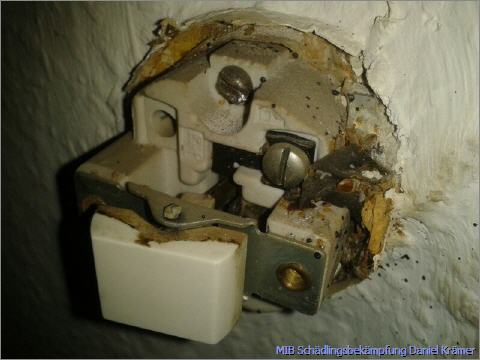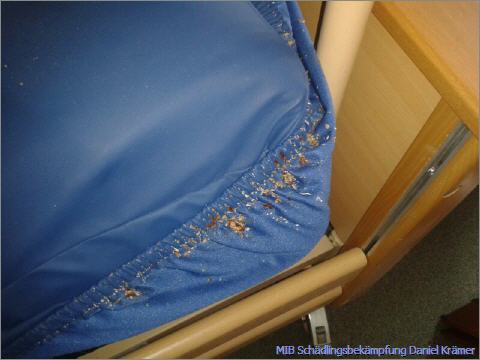Bed Bugs (Cimex lectularius) - the Checklist
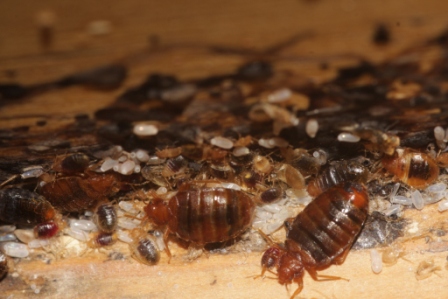 Other colloquial names: bloodsucker, bug, kissing bug, conenose
Other colloquial names: bloodsucker, bug, kissing bug, conenose
The MIBABS guide provides the following information concerning a possible bedbug infestation. The checklist concerns where and how you can determine, if there exists a bedbug infestation.
The MIBABS - Bed Bug Checklist:
- Preparatory Measures
- What do I do with the inventory/items?
- Popular hiding places for bed bugs
- Development time of the bed bugs depends on the temperature
- Here are a few simple tips before moving into hotels to identify bed bug infestation
- When everything is too late and you are on your way home with bed bugs in your luggage
Before it is too late and the bedbugs are already in your baggage, please call us
in Berlin und Brandenburg: (030) 44 73 18 71
Book recommendation: Die Bettwanzen-Fibel (First Edition 2019, german)
- written by our co-worker:
Dr. Oliver Zompro (order here)
Preparatory Measures
- Initially, upon a suspected infestation, do not remove anything from the affected area/room. The infestation would be simply transported to another area.
- Wash all clothing in 60 °C (140 °F) hot water for 30 min. or use a dryer, set at 40-45 °C (104-115 °F) for 30 min.
- With non-washable textiles, place into a freezer compartment, set at -18 °C (0 °F) for about 10 hours.
- Electronic devices could also be affected (MIBABS will not treat electronics like alarm clocks, TVs, radios, laptops etc.). They should be placed into a sealable plastic bag for 6 months, the bugs would eventually starve and die.
- Now, examine and clear all areas in which the bedbugs can hide. Take apart the bed. Remove the mattress, bed-skirts, open up the frame to allow easy access for a complete / thorough vacuuming (for an older mattress, it may make sense to buy a new one).
- Now vacuum the bed frame and mattresses (especially the seams) thoroughly.
- Clean under the bed, floors, crevices along the walls, essentialy every nook and cranny. Once this deep-cleaning is performed, remove the vacuum-bag and place in the trash bin, immediately, outside of the house. Another preparation technique would be the use of a steamer. The advantage is the steam will kill the insect's eggs, as well.
- Disassemble sockets (after turning off the power).
- Remove unused dowels (wall plugs) from the wall.
- Take framed artwork and wall hangings off the wall, look for tiny dark red points on surfaces. These red dots indicate insect excretions.
- Move furniture and beds away so that all areas can be reached easily before pest control.
- Follow the cleaning and ventilation instructions after the pest control treatment.
- For safety, pull the bed frame away from the wall and cover the legs of the bed with double-sided adhesive tape.
What do I do with the inventory/items?
- Bed bugs in loft bed
The loft bed should always be disassembled if possible.
If not, the extermination process is more difficult and time-consuming.
Any cracks and joints along the base of walls or tiles could be covered with tape or sealed with a filler, to starve the bugs (in practice, however, this has never really worked). - Bed bugs on shelves with books
One needs to search through the books on shelves for the "darkred-dots" and eggs, vacuum around and provide access behind the bookstand.
The books can be bagged and placed in the basement for minimum 6 months, to again, starve the critters.
Of course, the books can be trashed or placed in a heat-treatment facility (a dry sauna for example). - Bed bugs in couch
If the couch has a wooden frame and/or is covered with leather or fabric, the bed bugs can nest deeply here.
If the couch is only covered with fabric from below, you can loosen the staples / nails there and usually look into the wooden frame.
This frame can then be examined for traces of bed bugs and must be included in the treatment.
The couch can also be treated in a dry sauna or under a heat tent.
- Bed bugs in mobile (cellular) phone
A mobile phone could also be a possible hiding place.
The mobile phone can be heated to 60 °C (140 °F) in the oven (use a thermometer).
The device can withstand this heat and be 100% effectively cleared.
The mobile phone can handle it (in a car in summer it has to do that too - however, we do not guarantee this statement). - Bed bugs in notebook or desktop computer
The same applies here as for mobile phones: work carefully with heat (do not use more than 60 ° C [140 ° C], use a thermometer).
Or place the unit into a sealed bag for about 6 months in a dry basement celler (the bed bugs will starve). - Bed bugs behind photographs and artworks
Framed artwork and pictures also needs to be taken down.
On the back of the frame there can also be bed bugs and eggs in the corners.
Either throw it away or place it in the basement in a well-sealed bag for 6 months.
Insensitive pictures can be handled with care on the back of the frame (no guarantee the consequences of this recommendation). - Bed bugs in wall plug holes
Dowel holes can be closed with a wall putty.
Treatment with an insecticide must be carried out by the pest control company. - Bed bugs in compact discs (CDs)
CDs and Covers need to be visually searched for any bugs and eggs.
Simply opening and shaking out any bugs / eggs onto a dark surface is an easy way.
If evidence is found, either the heat or cold treatment (no guarantee) for CD-Cover is possible.
Again, just sealed up in a bag for 6 months is safer. - Bed bugs in LP record sleeves
Records can be taken out of their cases one by one to search for bugs and eggs.
However, we recommend placing collections in sealed plastic bags for 6 months.
Cold and heat treatment is possible, but not recommended. - Bed bugs in musical instruments
Infested musical instruments, especially wooden instruments, are a difficult topic.
If possible, sealing up and stored away for the best solution.
The application of heat could have fatal consequences due to the possible use of adhesives.
Special treatment in urgent cases is possible.
- Bed bugs in clothing
Clothing infected with bedbugs must, if possible, be washed at 60 °C (140 °F). Sensitive Option is deep freeze for at least 2 days at -18 °C (0 °F).
Best is to start in stages, a few articles at a time, with the rest bagged-up until their turn.
Though not every article of clothing will be infected, it is advised to handle every piece.
Please do not use pestcides on fabrics which are worn, close to the skin. - Bed bugs on or in bedding
Bed sheets, blankets, pillow cases, etc. need to be folded up and placed into a sealable bag, until washed at 60 °C (140 °C).
Please don't loosely carry around the bedding, as the insects or eggs could fall out. - Bed bugs on the pillow
Pillows need to be included in the wash at 60 °C (140 °F), as well. - Bed bugs in the mattress
Bed bugs usually sit in the mattress seams, but sometimes they don't.
First you can vacuum the mattress thoroughly.
Treatment with a steam cleaner kills all insect stages well.
Heating in a dry sauna or in a heating chamber is also advisable here.
Depending on the age of the mattress, you can also think about buying a new one.
A matress protector can be obtained which will prevent re-infestation (and even keep it dry).
The covering will also help allergy sufferers: protects against dust mites, fluids, urine, perspiration, allergens and bacteria. - Bed bugs in antiques
Bedbugs found in antiques are the same as in newer furniture.
They can be inside crevices, joints and hardware.
Their excrement is often the same color as the wood and is difficult to see. - Bed bugs in folders and stacks of papers
Bedbugs can be found in folders of paperwork and loose stacks of papers.
These can be sealed up or disposed. Any other kind of treatment is not recommended. - Bed bugs in furniture
The furniture in the infested area, in which bed bugs could be found, must be cleared.
Treatment from the inside and outside is recommended here. - Bed bugs behind panels
Paneling that you cannot see behind are a hindrance to pest control.
They must be removed for better control and treatment. - Bed bugs in cable ducts
Floors and walls with cable ducts need to be opened, accessible for control and/or treatment.
Openings for enclosed cable can be sealed with tape or putty.
The list is endless, however, I think a course of action in preparation is recognizable.
The photos with detailed signs of infestations are at the bottom of the page.
Popular hiding places for bed bugs
- alarm clocks, floor moldings and trim, around doors, windows and curtains
- look under loose floor coverings, mats, along the floor.
- around / in electrical sockets and switchplates, fuse box, telephones and other devices are good hiding places.
- the creases/crevices from stuffed chairs, sofas, window seats, bedframe and headboard, mattresses and bedding, closets, drawers, behind mirrors
- on curtains and curtain rails
If nothing is discovered, that is a good sign.
But, if one is bitten or an intense itch somewhere on the body, notify the staff.
Many hotels and hostels cannot be infested because bed bugs are brought in and spread by travelers!
But note that if an infestation is confirmed, you can tell from the actions of those responsible where you have landed.
Development time of the bed bugs depends on the temperature
13 °C (55 °F) development standstill
15 °C (59 °F) 237 days
18 °C (64 °F) 125 days
23 °C (73 °F) 61 days
25 °C (77 °F) 40 days
28 °C (82 °F) 34 days
Development stops at below 13 °C (55 °F), at less than 9 °C (13 °F) the ingestion is stopped.
The lifespan of adult bed bugs is also temperature-dependent and is 9-18 months at 18-20 °C (64-68 °F) and 10 weeks at 34 °C (93 °F).
Important!
- When the exterminator is called in, please have information on what insecticides have been used.
- That will prevent a risk of chemical interaction.
- With proper preparation, it is possible that only one treatment will suffice to rid the area of an infestation.
- Without a sufficient prep, most likely a second or more, session, within 10-20 days, will be required.
- After a period of 2-3 months without a sign of re-appearance of bedbugs, one can be certain of a successful eradication.
- Be advised that a one-time room-fogging eradication, frequently advertised, is insufficient.
Heat treatment is faster, but it may not be feasible everywhere and is associated with significantly higher expenditure and costs.
Here are a few simple tips before moving into hotels to identify bed bug infestation
Check out our website, or any exterminator's, for images of development stages of bedbugs.
- Once one begins a cursory inspection of the bed.
- Remove the sheets run a finger along the mattress seams, looking for moulted shells and bloodstained excrement (The telltale deep red or black "dots").
- On fabrics and wood, the stains will be dark, almost black.
- Whereas, on hard, polished surfaces, the stains will be more reddish in color and can be easily removed with a wet paper towel.
- The typical spots are found along the rigid outer seam, topside and bottom side.
- Check the bedframe, headboard, and supports, including joints
When everything is too late and you are on your way home with bed bugs in your luggage
- If at home and discover the critters have nested in the suitcases/ carry-on/ laptop case, go directly to the bathroom and place every item into the bathtub, or, shower stall.
- Strip off all clothes and put on new/fresh items not taken, instead.
- Grab large volume sealable trash bags, place everything into them and seal the bags.
- Take the wrapped suitcases down to cellar.
- The worn/washable items are then to be washed 60 °C (140 °F) for 30 min , or, dried 40-45 °C (105-115 °F) 30 min in a dryer.
- Delicate items can be wrapped and placed in a freezer with at least -18 °C (0 °F) for 2 days.
- Electronic devices could also be affected (MIBABS will not treat delicate textiles nor electronics, alarm clocks, radios, laptops, etc.).
- They should be placed into a sealable plastic bag for 6 months, the bugs would eventually starve and die.
Interesting links about bed bugs:
European Code of Practice - Bedbug Management (in english, en français, en español, in italiano, in het nederlands, in deutsch)
Pest Control Procedures Bed Bugs en français, w języku polskim, en español, in italiano
A Code of Practice for the Control of Bed Bug Infestations in Australia
Different bed bug photos
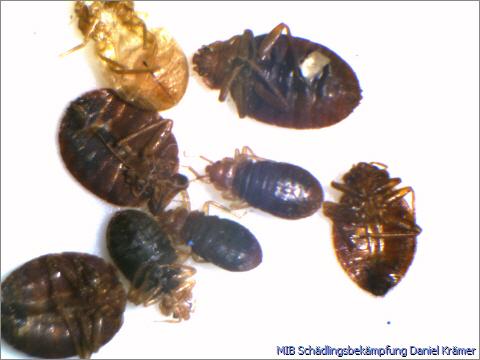
Bed bug, not fully grown
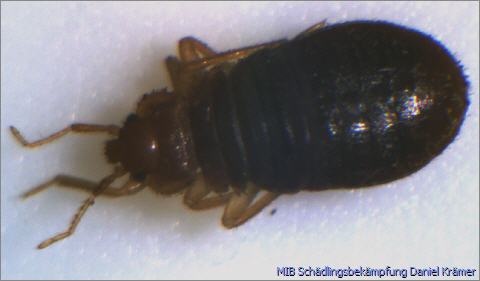
Bed bug head with proboscis
Front part of a bed bug shell (molting residue)
Rear part of a bed bug shell (molting residue)
Bedbugs nest
Hotel room wall behind a shelf on the bed
Bed bugs + bed bugs feces + bed bugs eggs + molting remains
Eggs from bed bugs
Thermal damage to a bed bug egg after heat treatment
Massive bed bug feces
Bed bug feces - visible as black-gray spots
Bed bug feces on the bed frame
Bed bug feces around socket frame and dowel
Bed bugs feces at the breakthrough of the wall
Bed bugs in the bed frame
Crushed bed bug
Fecal traces on the outer bed box
Bed bug in wood milling
Bed bugs in the bed frame 01
Bed bugs in the bed frame 02
Bed bugs in the bed frame 03
Bed bug nest on a mattress
Bed bug traces on the wall
Clear traces of bed bugs
Bed bug traces on an electrical outlet
Traces of bed bugs
Bed bugs in bed
Clear traces of bed bugs on the bed frame
Bed bugs in a bed frame in cutouts
Bed bug traces on the wooden frame
Bed bug bites
Bed bug excrements that run in the wood fiber direction
Bed bugs still alive
Bed bugs at a light switch
Bed bugs on a sheet
Did the information help you?
Then please give us feedback in the guest book.
We work according to:
MIBABS Schädlingsbekämpfung GmbH
Alt-Buch 72
13125 Berlin
Geschäftsführer: Daniel Krämer
E-Mail:
Quellenangabe für verwendete Bilder und Grafiken:


